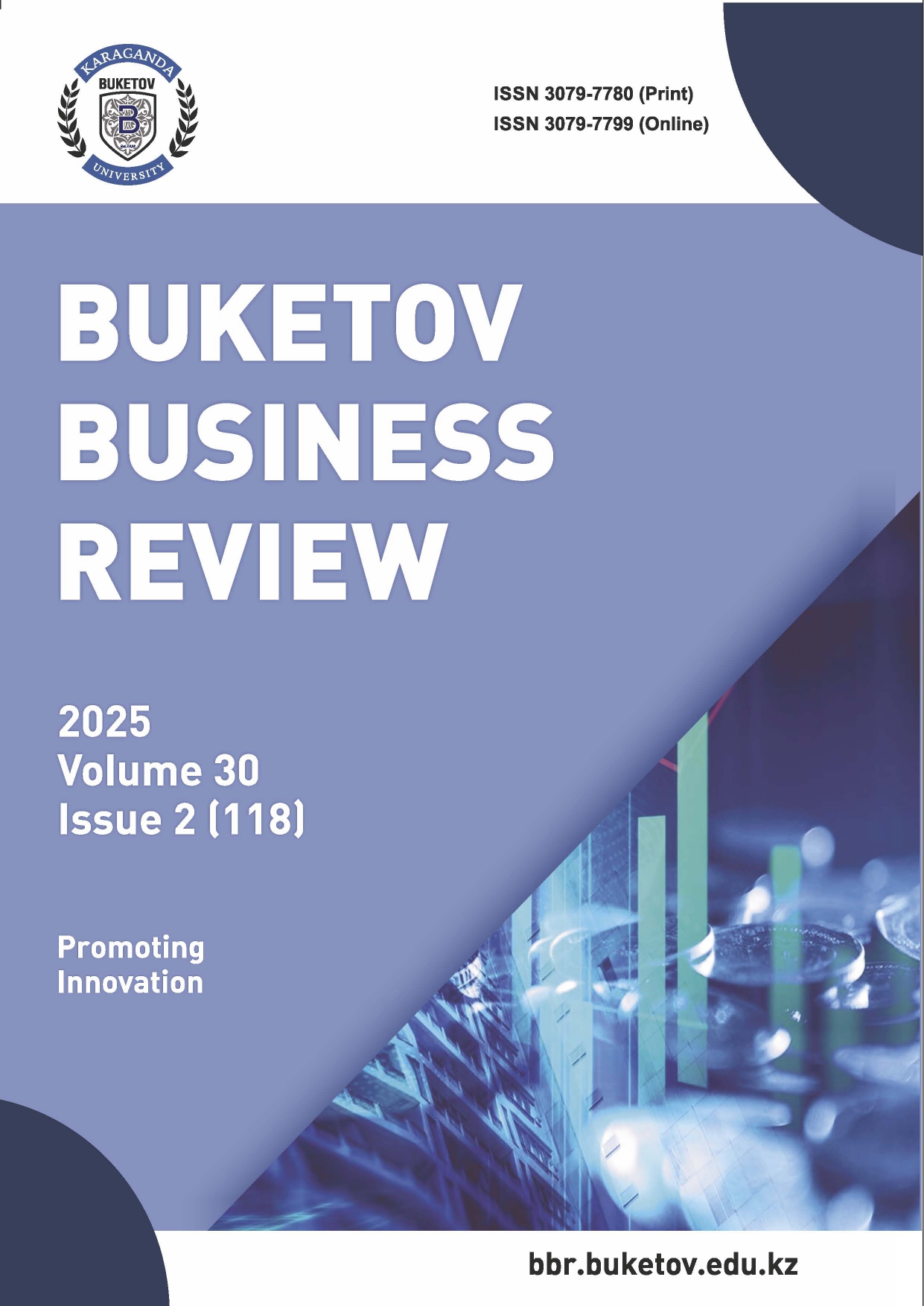Neuromarketing Insights: Using Eye-Tracking and Machine Learning to Understand Consumer Preferences for University Promotional Products
DOI:
https://doi.org/10.31489/2025ec2/4-16Keywords:
Neuromarketing, Eye-tracking technology, Consumer behavior, Promotional products, Visual engagement, Machine learningAbstract
This research applies neuromarketing approaches along with traditional marketing tool like self-report to study how design factors, such as visual appeal, quality and pricing, affect consumer engagement with promotional products at Almaty Management University. It explores how eye-tracking measures affect consumer preferences and how machine learning can be used to predict consumer behavior. 16 university students and young professionals participated in this quantitative study and interacted with a range of promotional items, including clothing, stationery and dishware. Gaze patterns and fixation durations were recorded using eye-tracker technology, and data including survey results were analyzed using machine learning model such as random forest classifiers to find patterns in consumer preferences. The results suggest that visually appealing designs increase consumer attraction and perceived attractiveness, especially in clothing. Eye-tracking metrics, such as size (cm2) and dwell time, were strongly correlated with attractiveness ratings and were identified by machine learning models as key features in predicting. The study emphasizes the importance of visual appealing products in increasing consumer engagement and brand loyalty. This study offers insightful information about how eye-tracking and machine learning can be used to predict consumer behavior in the context of promotional products. The results highlight how important visual design is in attracting consumers, by offering practical implications for marketers to improve promotional products.
References
Aldayel, M., Ykhlef, M., & Al-Nafjan, A. (2020). Deep learning for EEG-based preference classification in neuromarketing. Applied Sciences (Switzerland), 10(4), Article 1525. https://doi.org/10.3390/app10041525
Alsharif, A.H., Md Salleh, N.Z., Abdullah, M., Khraiwish, A., & Ashaari, A. (2023). Neuromarketing tools used in the marketing mix: A systematic literature and future research agenda. SAGE Open, 13(1), Article 21582440231156563. https://doi.org/10.1177/21582440231156563
Ariely, D., & Berns, G.S. (2010). Neuromarketing: The hope and hype of neuroimaging in business. Nature Reviews Neuroscience, 11(4), 284–292. https://doi.org/10.1038/nrn2795
Belch, G.E., & Belch, M.A. (2009). Advertising and promotion: An integrated marketing communication perspective (9th ed.). Irwin/McGraw-Hill.
Bulling, A., & Wedel, M. (2019). Pervasive eye tracking for real-world consumer behavior analysis. In M. Schulte-Mecklenbeck & A. Kühberger (Eds.), A handbook of process tracing methods for decision research: A critical review and user’s guide (pp. 27–44). Taylor & Francis. https://collaborative-ai.org/publications/bulling19_tf/
ESOMAR. (n.d.). Guideline for researchers and clients involved in primary data collection. https://esomar.org/code-and-guidelines/guideline-for-researchers-and-clients-involved-in-primary-data-collection
Gao, H., & Kasneci, E. (2022). Eye-tracking-based prediction of user experience in VR locomotion using machine learning. Computer Graphics Forum, 41(7), 589–599. https://doi.org/10.1111/cgf.14703
Goldberg, P., Sümer, Ö., Stürmer, K., Wagner, W., Göllner, R., Gerjets, P., Kasneci, E., & Trautwein, U. (2021). Attentive or Not? Toward a Machine Learning Approach to Assessing Students’ Visible Engagement in Classroom Instruction. Educational Psychology Review, 33(1), 27–49. https://doi.org/10.1007/S10648-019-09514-Z
Janiszewski, C. (1998). The influence of display characteristics on visual exploratory search behavior. Journal of Consumer Research, 25(3), 290–301. https://doi.org/10.1086/209540
Juárez-Varón, D., Tur-Viñes, V., Rabasa-Dolado, A., & Polotskaya, K. (2020). An Adaptive Machine Learning Methodology Applied to Neuromarketing Analysis: Prediction of Consumer Behaviour Regarding the Key Elements of the Packaging Design of an Educational Toy. Social Sciences, 9(9), 162. https://doi.org/10.3390/socsci9090162
Kahneman, D. (2011). Thinking, fast and slow. Penguin Books.
Kazybayeva, A.M. (2022). Neuromarketing. Balausa.
Kim, J.Y., & Kim, M.J. (2024). Identifying customer preferences through eye-tracking in travel websites focusing on neuromarketing. Journal of Asian Architecture and Building Engineering, 23(2), 515–527. https://doi.org/10.1080/13467581.2023.2244566
Li, J., Abbasi, A., Cheema, A., & Abraham, L.B. (2020). Path to purpose? How online customer journeys differ for hedonic versus utilitarian purchases. Journal of Marketing, 84(4), 127–146. https://doi.org/10.1177/0022242920911628
Macalik, J. (2023). Personal Brand—Instructions of Use. Do Young Professionals Want and Need to be Taught Personal Branding? Marketing of Scientific and Research Organizations, 48(2), 41–60. https://doi.org/10.2478/minib-2023-0009
Martinovici, A., Pieters, R., & Erdem, T. (2022). Attention Trajectories Capture Utility Accumulation and Predict Brand Choice. Journal of Marketing Research, 60, 625–645. https://doi.org/10.1177/00222437221141052
Mashrur, F.R., Rahman, K.M., Miya, M., Vaidyanathan, R., Anwar, S.F., Sarker, F., & Al Mamun, K.A. (2023). Intelligent neuromarketing framework for consumers’ preference prediction from electroencephalography signals and eye tracking. Journal of Consumer Behaviour. https://doi.org/10.1002/cb.2253
Pieters, R., & Wedel, M. (2004). Attention capture and transfer in advertising: Brand, pictorial, and text-size effects. Journal of Marketing, 68(2), 36–50. https://doi.org/10.1509/jmkg.68.2.36.27794
Salazar Olarte, C.A. (2021). Pupilometría y el eye tracking como herramientas del neuromarketing. Vivat Academia, 227–243. https://doi.org/10.15178/va.2021.154.e1345
Šola, H.M., Qureshi, F.H., & Khawaja, S. (2025). AI and Eye Tracking Reveal Design Elements’ Impact on E-Magazine Reader Engagement. Education Sciences, 15(2), 203. https://doi.org/10.3390/educsci15020203
Unger, M., Wedel, M., & Tuzhilin, A. (2023). Predicting consumer choice from raw eye-movement data using the RETINA deep learning architecture. SSRN Electronic Journal. https://doi.org/10.2139/ssrn.4341410
Vozzi, A., Ronca, V., Aricò, P., Borghini, G., Sciaraffa, N., Cherubino, P., Trettel, A., Babiloni, F., & Di Flumeri, G. (2021). The Sample Size Matters: To What Extent the Participant Reduction Affects the Outcomes of a Neuroscientific Research. A Case-Study in Neuromarketing Field. Sensors, 21(18), 6088. https://doi.org/10.3390/s21186088
Xie, W., Lee, M.H., Chen, M., & Han, Z. (2024). Understanding consumers’ visual attention in mobile advertisements: An ambulatory eye-tracking study with machine learning techniques. Journal of Advertising, 53(3), 397–415. https://doi.org/10.1080/00913367.2023.2258388
Downloads
Published
Issue
Section
License
Copyright (c) 2025 BUKETOV BUSINESS REVIEW

This work is licensed under a Creative Commons Attribution-NonCommercial-NoDerivatives 4.0 International License.



